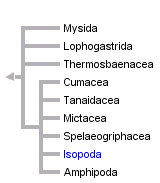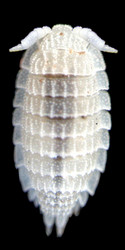Peracarida



This tree diagram shows the relationships between several groups of organisms.
The root of the current tree connects the organisms featured in this tree to their containing group and the rest of the Tree of Life. The basal branching point in the tree represents the ancestor of the other groups in the tree. This ancestor diversified over time into several descendent subgroups, which are represented as internal nodes and terminal taxa to the right.

You can click on the root to travel down the Tree of Life all the way to the root of all Life, and you can click on the names of descendent subgroups to travel up the Tree of Life all the way to individual species.
For more information on ToL tree formatting, please see Interpreting the Tree or Classification. To learn more about phylogenetic trees, please visit our Phylogenetic Biology pages.
close boxReferences
Bowman, T. E., S. P. Garner, R. R. Hessler, T. M. Iliffe, and H. I. Sanders. 1985. Mictacea, A New Order Of Crustacea Peracarida. Journal of Crustacean Biology 5:74-78.
Casanova, J. P., L. De Jong, and E. Faure. 1998. Interrelationships of the two families constituting the Lophogastrida (Crustacea: Mysidacea) inferred from morphological and molecular data. Marine Biology 132:59-65.
Gordon, I. 1957. On Spelaeogriphus, a new cavernicolous crustacean from South Africa. Bull. Br. Mus. Nat. Hist. Zool. 5:31-47.
Hessler, R. R. and L. Watling. 1999. Les Péracarides: un groupe controversé. Pages 1-10 in Traité de Zoologie. Anatomie, Systématique, Biologie. Tome VII, Fascicule IIIA, Crustacés Péracarides. J. Forest, ed. Mémoires de l'Institut Océanographique Fondation Albert Ier, Prince de Monaco 19.
Kim, C. B. and W. Kim. 1993. Phylogenetic relationships among gammaridean families and amphipod suborders. Journal of Natural History 27:933-946.
Kobusch, W. 1998. The foregut of the Mysida (Crustacea, Peracarida) and its phylogenetic relevance. Philosophical Transactions of the Royal Society of London Series B 353:559-581.
Richter, S. and G. Scholtz. 2001. Phylogenetic analysis of the Malacostraca (Crustacea). Journal of Zoological Systematics and Evolutionary Research 39:113-136.
Spears, T. and L. G. Abele. 1998. Crustacean phylogeny inferred from 18S rDNA. Pages 169-187 in Arthropod Relationships. R. A. Fortey and R. H. Thomas, eds. Systematics Association Special Volume Series 55. Chapman & Hall, London.
Whittington, H. B. and W. D. U. Rolfe (eds.). 1963. Phylogeny and Evolution of Crustacea. Museum of Comparative Zoology, Cambridge.
Wills, M.A. 1998. A phylogeny of Recent and fossil Crustacea derived from morphological characters. Pages 189-209 in Arthropod Relationships. R. A. Fortey and R. H. Thomas, eds. Systematics Association Special Volume Series 55. Chapman & Hall, London.
Title Illustrations

| Scientific Name | Caprella sp. |
|---|---|
| Location | 49 km W of San Jose, California, USA |
| Comments | Skeleton Shrimp (Caprella sp.) were EVERYWHERE on the ostrich plume hydroids (Aglaophenia sp.), even out of the water. I was reading Between Pacific Tides the night before, and they mentioned Aglaophenia latirostris was a great habitat for pycnogonids, so I kept sifting and sifting through the hydroids (Minette, I even used my little net!), but alas, no sea spiders. Still, caprellids rock, so I was happy to find them instead. |
| Specimen Condition | Live Specimen |
| Source | Like an Angel ... FROM HELL! |
| Source Collection | Flickr |
| Image Use |
 This media file is licensed under the Creative Commons Attribution-NonCommercial-ShareAlike License - Version 2.0. This media file is licensed under the Creative Commons Attribution-NonCommercial-ShareAlike License - Version 2.0.
|
| Copyright |
© 2008 Ken-ichi Ueda

|
| Scientific Name | Gnathophausia ingens |
|---|---|
| Location | Monterey Bay Aquarium (Monterey County, California, US) |
| Comments | Deep water giant red mysid. |
| Source Collection | CalPhotos |
| Copyright |
© 2000 Joseph Dougherty

|
| Scientific Name | Platyarthrus aiasensis |
|---|---|
| Specimen Condition | Live Specimen |
| Identified By | Giuseppe Montesanto |
| Sex | Female |
| Image Use |
 This media file is licensed under the Creative Commons Attribution-NonCommercial License - Version 3.0. This media file is licensed under the Creative Commons Attribution-NonCommercial License - Version 3.0.
|
| Copyright |
©

|
About This Page
Page copyright © 2002
All Rights Reserved.
Citing this page:
Tree of Life Web Project. 2002. Peracarida. Version 01 January 2002 (temporary). http://tolweb.org/Peracarida/6310/2002.01.01 in The Tree of Life Web Project, http://tolweb.org/











 Go to quick links
Go to quick search
Go to navigation for this section of the ToL site
Go to detailed links for the ToL site
Go to quick links
Go to quick search
Go to navigation for this section of the ToL site
Go to detailed links for the ToL site